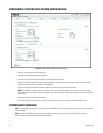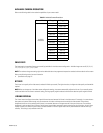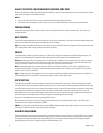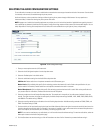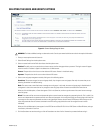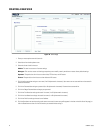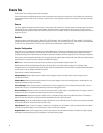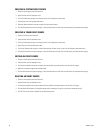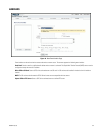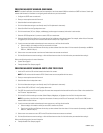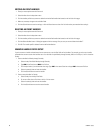63 C2963M-C (8/10)
Events Tab
Use the Events tab to configure camera events and analytics.
Events are activated by user-defined event sources that tell the device how to react when an event occurs. Event handlers are the actions that
the device takes when an event occurs. For example, a system source can be configured to send email to an operator if the system shuts-down
and restarts.
Sources
The camera supports one physical input alarm source, a system source, and a timer source. The Alarm source is the camera input for an external
signaling device, such as a door contact or motion detector. The System source is activated when the camera restarts. The Timer source is a
user-defined event that activates an event after a specified amount of time. For example, the timer can be activated every 60 seconds to save an
image to an SD card.
Handlers
The device supports a Send Email handler, a “Write JPEG to SD Card handler,” and an “Upload JPEG to FTP Server handlers.” The Send Email
handler sends an email to a defined email address when an event is activated. The “Write JPEG to SD Card” saves a JPEG of the activated event
to an SD card. The “Upload JPEG to FTP Server” saves a JPEG of the activated event to a defined FTP server.
Analytic Configuration
Pelco analytics can be configured and enabled using a standard Web browser. The device is preloaded with user-configurable behaviors and is
capable of running several behaviors at the same time. The number of behaviors is limited to the available processing power of the device.
Available processing power is determined by the settings for compression standards, resolution, image rate, bit rate, and analytic configuration.
Pelco analytics are also compatible with Endura
®
or a third-party system that supports Pelco’s Analytics API system. Refer to the specific product
documentation for instructions on how to configure and enable Pelco analytics.
NOTE: Analytic alerts can be seen in the event stream, but alarms are only transmitted through the analytics API.
Models are also available with ObjectVideo
®
(OV) Suites. OV Suites require an OV ready-compliant system with an OV Ready
™
video
management system to configure and enable the OV Analytic Suites that are preloaded on the camera. Refer to the ObjectVideo documentation
for instructions on how to configure and enable OV analytics.
Pelco analytics include the following behaviors:
Abandoned Object: Detects objects placed in a defined zone and triggers an alarm if the object remains in the zone longer than the
user-defined time allows.
Adaptive Motion: Detects and tracks objects that enter a scene and then triggers an alarm when the objects enter a user-defined zone. The
objects are monitored until they exit the scene.
Camera Sabotage: Detects contrast changes in the field of view. An alarm is triggered if the lens is obstructed with spray paint, a cloth, or
covered with a lens cap. Any unauthorized repositioning of the camera also triggers an alarm.
Directional Motion: Generates an alarm in a high traffic area when a person or object moves in a specified direction. For example, a camera is
pointed at an exit door. If someone tries to enter through the exit door, an alarm triggers.
Loitering Detection: Identifies when people or vehicles remain in a defined zone longer than the user-defined time allows. This behavior is
effective for real-time notification of suspicious behavior around ATMs, stairwells, and school grounds.
Object Counting: Counts the number of objects that enter a defined zone or cross a defined trip wire. This behavior can be used to count people
at a store entrance/exit or inside a store where the traffic is light.
Object Removal: Triggers an alarm if an object is removed from a user-defined zone. This behavior is ideal for customers who want to detect
the removal of high-value objects, such as a painting from a wall or a statue from a pedestal.
Stopped Vehicle: Detects vehicles stopped near a sensitive area longer than the user-defined time allows. This behavior is ideal for parking
enforcement, suspicious parking, traffic lane breakdowns, and vehicles waiting at gates.



